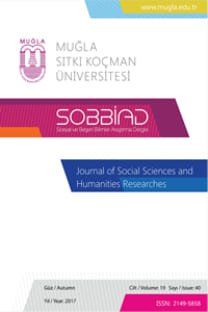Türkiye’de Dil Öğretiminde Motivasyon ve Verimliliği Arttırmaya Yönelik İlgi Tabanlı Dil Öğretimi
Bu çalışma İngilizcenin yabancı dil olarak öğretildiği bir sınıfta yapılan ve ilgi tabanlı dil öğretiminin (IBLT) içsel güdüleme ve dil çıktıları üzerine etkilerini inceleyen bir aksiyon çalışmasının sonuçlarını ortaya koyar. IBLT, günümüzde değer verilen iletişimsel dil öğretimin bir parçası olarak kabul edilebilir çünkü belli bir amaç için dil öğrenme, metin ve öğrenci, aynı zamanda öğrenciler arasında etkileşim ve anlam pazarlığı ve bir muhatap için bildirim unsurlarını içinde barındırır. Çalışma, IBLT’ nin içsel güdülemeyi ortaya çıkarma noktasında potansiyele sahip olduğunu, bu yolla sınıf içi faaliyetleri kayda değer miktarda artıracağını, öğrencinin bilişsel katılımını harekete geçireceğini ve nihayet kaliteli bir dil çıktısı üreteceğini iddia eder. Çalışma Türkiye’de bir lisede okuyan ve dil seviyesi alt-orta olan İngilizce öğrencileri üzerinde yapılmıştır. Ön ve son testlerle toplanan veri, IBLT’ nin öğrencilerin yazma çıktıları üzerinde herhangi bir olumlu etki yapıp yapmadığını anlamak üzere analiz edilmiştir. Sonuçlar göstermiştir ki yazma çıktılarının miktarını ve kalitesini kayda değer bir biçimde artırmıştır. Sonuçlar ışığında, IBTL sınıflarında düşük güdülemeden, az derse katılımdan ve hedef dilde az çıktıdan şikâyet eden dünyanın her yerindeki dil öğretmenlerine önerilir.
Anahtar Kelimeler:
İlgi tabanlı dil öğretimi, motivasyon
INTEREST-BASED LANGUAGE TEACHING TO INCREASE MOTIVATION AND OUTPUT IN TURKEY
The study reports the results of an action research conducted in an English as a Foreign Language classroom to examine the effects of Interest-Based Language Teaching (IBLT) on intrinsic motivation and language production. IBLT can be considered a part of treasured communicative language practice, for it includes language use for a specific purpose, interaction between text and learner as well as among learners, negotiation of meaning and reporting for an audience. The study argues for the position that IBLT has the potential to generate intrinsic motivation, and thus increase participation in classroom activities considerably, activate learners’ cognitive involvement, and as a consequence produce quality learner output. The study was conducted on pre-intermediate learners of English in a classroom at a high school in Turkey. The collected data through pre- and post-tests were examined to see whether IBTL had any positive impact on learners’ writing. The results reveal that IBTL considerably improved the amount and quality of writing. Based on the results, IBTL is recommended to language practitioners around the world who experience low levels of motivation and participation, and poor output in the target language.
Keywords:
Interest-based language teaching, motivation,
___
- Brinton, D. M., & Snow, M. A. (1997). Content-based classroom. New York: Longman.
- Brown, D. H. (2000). Principles of language learning and teaching. Englewood Cliffs, NJ: Prentice Hall.
- Deci, E.L., & Ryan, R.M. (1985). Intrinsic motivation and self-determination in human behavior. New York: Plenum Press.
- Ellis, R. (1997). The study of second language acquisition. Oxford: Oxford University Press.
- Ellis, R. (2003). Task-based language learning and teaching. Oxford: Oxford University Press.
- Ersöz, A. (2004). Intrinsic motivation in English language teaching. Education and Science, 29(132), 67-71.
- Gardner, R. C., & Lambert, W. E. (1972). Attitudes and motivation: Second language learning. London: Newbury House.
- Gardner, R. C. (1985). Social psychology and second language learning. London: Edward Arnold
- Krahnke, K. (1987). Approaches to syllabus design for foreign language teaching. New York: Prentice Hall.
- Lave, J., & E. Wenger (1991). Situated learning: Legitimate peripheral participation. Cambridge: Cambridge University Press.
- Mackenzie, N. (2007). Teacher morale: More complex than we think? The Australian Educational Researcher, 31 (1), 89-104.
- Metcalfe, A., & A. Game (2006). The teacher’s enthusiasm. The Australian Educational Researcher, 33(3), 91-106.
- Nunan, D. (1992). Research methods in language learning. Cambridge: Cambridge University Press.
- Oxford, R., & Shearin, J. (1994). Language learning motivation: Expanding the theoretical framework. The Modern Language Journal, 78, 12-28.
- Raimes, A. (1991). Out of the woods: Emerging traditions in the teaching of writing. TESOL Quarterly, 25(3), 407-30.
- Richards, J. C., & Rodgers, T. S. (2001). Approaches and methods in language teaching. (2nd ed.)Cambridge, New York: Cambridge University Press.
- Scott, W.A., & Ytreberg, L. (1990). Teaching English to children. London: Longman.
- Spolsky, B. (2000). Anniversary article: long motivation revisited. Applied Linguistics, 21, 157-169.
- Vile, G. N. (1996). Content-based second language instruction. ELT Journal, 50(2), 108-114.
- ISSN: 2149-5858
- Yayın Aralığı: Yılda 2 Sayı
- Başlangıç: 2000
- Yayıncı: Mugla Sitki Kocman University
Sayıdaki Diğer Makaleler
ANA DİLİ ÖĞRETİMİNE YENİ YAKLAŞIMLAR
KÜRESELLEŞME VE DEMOKRASİ KRİZİ
KARİYER DEĞERLERİ VE KARİYER YOLU TERCİHLERİ İLİŞKİSİ: TÜRK TURİZM SEKTÖRÜNDEN ÖRNEKLER
II. DÜNYA SAVAŞI YILLARINDA EGE ADALARI’NDAN BATI ANADOLU SAHİLLERİNE SIĞINAN MÜLTECİLER MESELESİ
ERGENLERİN KİŞİLERARASI İLİŞKİLERİNİ ETKİLEYEN SOSYAL YAŞANTI DEĞİŞKENLERİNİN İNCELENMESİ
Songül TÜMKAYA, Metehan ÇELİK, Birsel AYBEK
KADIN GİRİŞİMCİLİĞİ VE MİKROFİNANS: TÜRKİYE DENEYİMİ
TEZSİZ YÜKSEK LİSANS ÖĞRENCİLERİNİN ÖĞRETMENLİK MESLEĞİNE YÖNELİK TUTUMLARI
Seyahat ve Cinsiyet: Bir Kadının Portresi
